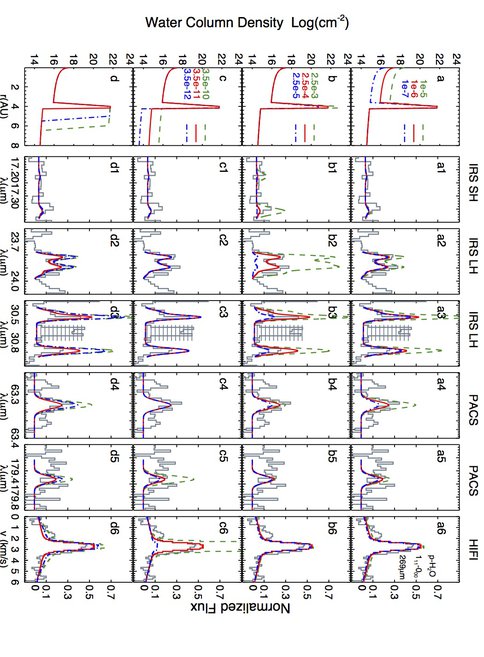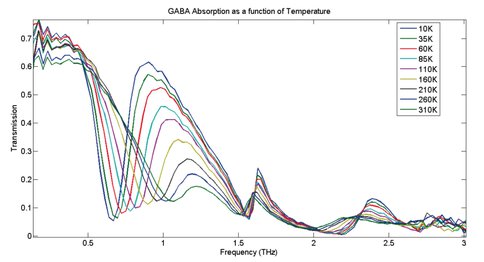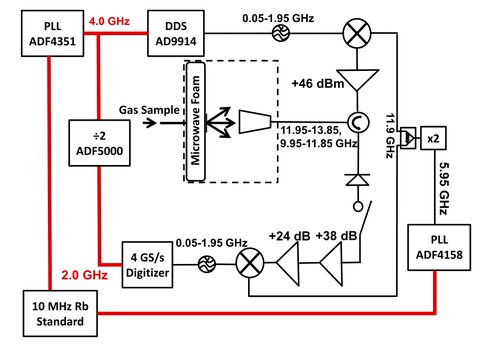2013 Annual Science Report
 NASA Goddard Space Flight Center
Reporting | SEP 2012 – AUG 2013
NASA Goddard Space Flight Center
Reporting | SEP 2012 – AUG 2013
NNX09AH63A Origin and Evolution of Organics in Planetary Systems
Project Summary
The Blake group has been carrying out joint observational and laboratory program with NAI node scientists on the water and simple organic chemistry in the protoplanetary disk analogs of the solar nebula and in comets. Observationally, we continue to build on our extensive (>100 disks) Spitzer IRS survey of the infrared molecular emission from the terrestrial planet forming region of disks with follow-up work using the high spectral resolution ground-based observations of such emission (via the Keck and the Very Large Telescopes, the Herschel Space Observatory, and ALMA) along with that from comets. This year, we emphasized the disk systems in which we have probed the outer disk’s water emission with the Herschel HIFI instrument. With Herschel PACS we have measured the ground state emission from HD for the first time, yielding much more accurate mass estimates, that we have used in turn to carry out the first detailed examination of the radial water abundance structure in the planet-forming environments represented by the so-called transitional disk class. In the laboratory, we have developed a novel approach to broad-band chirped pulse microwave spectroscopy that promises to drop the size, mass and cost of such instruments by one to two orders of magnitude. We are using the new instrument to measure the rotational spectra of prebiotic compounds, and our existing THz Time Domain Spectrometer to characterize their large amplitude vibrations. Looking forward, these techniques have the potential to make site-specific stable isotope measurements, a capability we will explore with GSFC Node scientists.
Project Progress
As part of the NASA GSFC NAI Node, Co-Investigator Blake is directing both lab & astronomical spectroscopy programs. The goal of these observations is to determine whether complex organics are detectable in the circumstellar accretion disks that encircle young stars and in the comae of comets. In particular, with NAI support we have used the high angular and spectral resolution data to study circumstellar disks, cometary comae, and extrasolar planetary atmospheres. For disks, we have begun to investigate whether the smoothly varying conditions in disks enable abundance profiles to be retrieved from even spatially and spectrally unresolved data (provided the lines span a significant range in excitation). We have termed this approach molecular mapping, and first applied it to water data from the Keck, Spitzer and Herschel observatories (see Figure 1, adapted from Zhang et al. 2013).
Because the organics in the inner regions of disks are so closely tied to water, we also used the HIFI instrument on Herschel to search for gas phase water signatures in the outer regions of disks and in comets, to great effect. We have made the first measurements of the D/H ratio in water from a Jupiter family comet, specifically Comet 103P Hartley 2 that was the subject of the EPOXI flyby, and have worked with the Mumma group on infrared observations using Keck in support of the EPOXI and Herschel campaigns. Interestingly, we find that the D/H ratio in Hartley is substantially lower than that in Oort cloud comets, and the same as that in the Earth’s oceans (Hartogh et al. 2011). Such Herschel observations are no longer possible, and so we have concentrated our efforts this past year on Keck NIRSPEC observations in collaboration with the GSFC team (see publications), especially the Comet ISON campaign in Oct-Nov 2013. The same high precision/high dynamic range routines needed to study disks and comets can also be used to explore the spectra of extrasolar planetary atmospheres, both in transiting and non-transiting systems (such as tau Boo, Lockwood et al. 2014).
The broad wavelength coverage of Herschel will also permit a much improved understanding of ices in disks, and thus the origin of icy bodies such as comets – but only if the necessary lab data are obtained. We have recently constructed a TeraHertz Time Domain Spectrometer, or THz TDS. With this instrument we now have complete coverage of the spectral ranges accessible to Herschel/SOFIA at a dynamic range of >106 and without any need for cryogens. We are first examining the THz TDS spectra of simple solid-state films or aqueous solutions, including cryogenic measurements. An instrument layout and sample data for the non-terrestrial amino acid GABA are shown in Figures 2 and 3. Similar data are available on the principal icy grain mantle components, on a suite of amino acids, and on >100 naturally occurring silicate and carbonate compounds. As can be seen, the structure of the THz signatures are sensitive to temperature; and so if eventually detected can provide not only species identification but a characterization of the physical state of the molecular ices on interstellar or protostellar grains as well.
The other area we are exploiting involves the rapid development of Direct Digital Synthesis (DDS) capabilities at microwave frequencies that we tie to astronomical surveys for complex organics. In particular, we have found that inexpensive DDS evaluation boards can replace (>$70k) arbitrary waveform generators in so-called chirpedpulse Fourier Transform Microwave (CP-FTMW) instruments. Schematic outlines of early results are shown in Figures 4 and 5. We have used these capabilities to search for and detect new organic species using the publically available PRIMOS survey (see McGuire et al. 2012, for example). Longer term, the great sensitivity of the CP-FTMW approach enables the non-destructive detection of stable isotopologues in natural abundance, and in a site-specific manner that can leverage a great deal of information about the formation pathways of organics in carbonaceous chondrites. We are thus working with Node scientists to carry out initial lab spectroscopy on moderately volatile prebiotic species.
Publications
-
Bergin, E. A., Cleeves, L. I., Gorti, U., Zhang, K., Blake, G. A., Green, J. D., … Van Dishoeck, E. F. (2013). An old disk still capable of forming a planetary system. Nature, 493(7434), 644–646. doi:10.1038/nature11805
-
Finneran, I. A., Holland, D. B., Carroll, P. B., & Blake, G. A. (2013). A direct digital synthesis chirped pulse Fourier transform microwave spectrometer. Review of Scientific Instruments, 84(8), 083104. doi:10.1063/1.4818137
-
Hartogh, P., Lis, D. C., Bockelée-Morvan, D., De Val-Borro, M., Biver, N., Küppers, M., … Blake, G. A. (2011). Ocean-like water in the Jupiter-family comet 103P/Hartley 2. Nature, 478(7368), 218–220. doi:10.1038/nature10519
-
McGuire, B. A., Loomis, R. A., Charness, C. M., Corby, J. F., Blake, G. A., Hollis, J. M., … Remijan, A. J. (2012). INTERSTELLAR CARBODIIMIDE (HNCNH): A NEW ASTRONOMICAL DETECTION FROM THE GBT PRIMOS SURVEY VIA MASER EMISSION FEATURES. The Astrophysical Journal, 758(2), L33. doi:10.1088/2041-8205/758/2/l33
-
Paganini, L., Mumma, M. J., Boehnhardt, H., DiSanti, M. A., Villanueva, G. L., Bonev, B. P., … Blake, G. A. (2013). GROUND-BASED INFRARED DETECTIONS OF CO IN THE CENTAUR-COMET 29P/SCHWASSMANN-WACHMANN 1 AT 6.26 AU FROM THE SUN. The Astrophysical Journal, 766(2), 100. doi:10.1088/0004-637x/766/2/100
-
Villanueva, G. L., Mumma, M. J., DiSanti, M. A., Bonev, B. P., Paganini, L., & Blake, G. A. (2012). A multi-instrument study of Comet C/2009 P1 (Garradd) at 2.1AU (pre-perihelion) from the Sun. Icarus, 220(1), 291–295. doi:10.1016/j.icarus.2012.03.027
-
Zhang, K., Pontoppidan, K. M., Salyk, C., & Blake, G. A. (2013). EVIDENCE FOR A SNOW LINE BEYOND THE TRANSITIONAL RADIUS IN THE TW Hya PROTOPLANETARY DISK. The Astrophysical Journal, 766(2), 82. doi:10.1088/0004-637x/766/2/82
-
PROJECT INVESTIGATORS:
-
PROJECT MEMBERS:
Geoffrey Blake
Project Investigator
Brandon Carroll
Collaborator
Daniel Holland
Collaborator
Alexandra Lockwood
Collaborator
-
RELATED OBJECTIVES:
Objective 1.1
Formation and evolution of habitable planets.
Objective 1.2
Indirect and direct astronomical observations of extrasolar habitable planets.
Objective 3.1
Sources of prebiotic materials and catalysts





